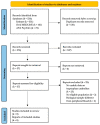The Kynurenine Pathway in Attention-Deficit/Hyperactivity Disorder: A Systematic Review and Meta-Analysis of Blood Concentrations of Tryptophan and Its Catabolites
- PMID: 38276089
- PMCID: PMC10815986
- DOI: 10.3390/jcm13020583
The Kynurenine Pathway in Attention-Deficit/Hyperactivity Disorder: A Systematic Review and Meta-Analysis of Blood Concentrations of Tryptophan and Its Catabolites
Abstract
Preliminary evidence shows that the kynurenine pathway (KP) may be altered in attention-deficit/hyperactivity disorder (ADHD). We thus conducted a systematic review and meta-analysis exploring the peripheral blood concentrations of tryptophan catabolites (TRYCATs) in people with ADHD. We searched the main electronic databases up to 7th December 2023. Standardised mean differences (SMDs) with 95% confidence intervals (95%CIs) were used to compare TRYCAT concentrations between participants with ADHD and healthy controls (HCs). We included eight studies. Random-effects meta-analyses found higher kynurenine (SMD = 0.56; 95%CI: 0.04 to 1.08; p = 0.033; I2 = 90.3%) and lower kynurenic acid (SMD = -0.33; 95%CI: -0.49 to -0.17; p < 0.001; I2 = 0%) concentrations in people with ADHD compared to HCs. Additional analyses on drug-free children with ADHD showed higher tryptophan (SMD = 0.31; 95%CI: 0.11 to 0.50; p = 0.002; I2 = 0%) and kynurenine (SMD = 0.74; 95%CI: 0.30 to 1.17; p < 0.001; I2 = 76.5%), as well as lower kynurenic acid (SMD = -0.37; 95%CI: -0.59 to -0.15; p < 0.001; I2 = 0%) blood levels, as compared to HCs. Despite some limitations, our work provides preliminary evidence on KP alterations in ADHD that may suggest decreased neuroprotection. Further research is needed to clarify the role of the KP in ADHD.
Keywords: attention-deficit/hyperactivity disorder; kynurenic acid; kynurenine pathway; meta-analysis; peripheral blood; systematic review; tryptophan catabolism.
Conflict of interest statement
The authors declare no conflicts of interest.
Figures


References
-
- Kessler R.C., Adler L., Barkley R., Biederman J., Conners C.K., Demler O., Faraone S.V., Greenhill L.L., Howes M.J., Secnik K., et al. The prevalence and correlates of adult ADHD in the United States: Results from the National Comorbidity Survey Replication. Am. J. Psychiatry. 2006;163:716–723. doi: 10.1176/ajp.2006.163.4.716. - DOI - PMC - PubMed
-
- Bartoli F., Callovini T., Cavaleri D., Cioni R.M., Bachi B., Calabrese A., Moretti F., Canestro A., Morreale M., Nasti C., et al. Clinical correlates of comorbid attention deficit hyperactivity disorder in adults suffering from bipolar disorder: A meta-analysis. Austr. N. Z. J. Psychiatry. 2023;57:34–48. doi: 10.1177/00048674221106669. - DOI - PubMed
Publication types
LinkOut - more resources
Full Text Sources

